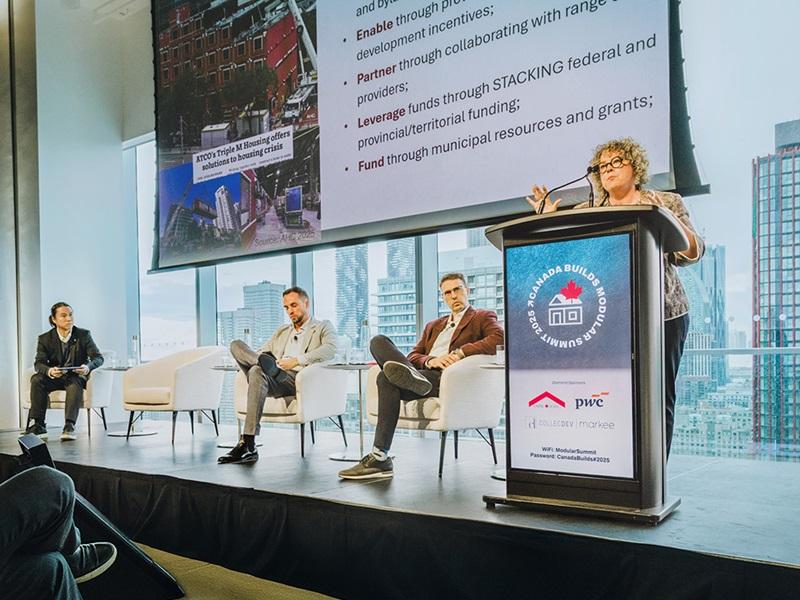
The construction economics for eco-friendly rentals in the Greater Toronto Area are getting a boost courtesy of a veteran builder who believes he’s found the “sweet spot” with his own Mimico-based prototype.
“Four units is the sweet spot in what I believe is going to be the new game in town for the next decade, maybe more,” Mike Manning, owner and president of Greenbilt Homes, told RENX Homes.
Greenbilt’s prototype, the Flex Plex, is only two units — Manning and his wife live in the bottom unit, and a family from abroad live on the upper level. But he notes the City of Toronto waives development charges on infill rental developments up to four units, and his company has designed housing to capitalize on that incentive.
In September, the federal government announced an HST break for rental construction developers, further ameliorating the economic viability of building purpose-built apartment dwellings in the country’s largest metropolitan region.
Manning also noted the provincial government’s goal to build 1.5 million new homes across Ontario by 2031 necessitates the types of incentives he said augment rental development.
Why Greenbilt is backing the Flex Plex
The Flex Plex, he added, presents an opportunity for young, aspirant homeowners to get a foot in the door and pay down mortgage balances with revenue generated from on-site rental units.
Moreover, the green building sector — which is mostly comprised of companies Manning called “the small guys” — will continue eating larger shares of the housing construction pie as Canada’s carbon tax becomes increasingly punitive every year until 2030, when it hits $170 per metric ton.
“The big guy has had a good run for a couple of decades building condos and stuff like that, but the government will now waive development charges and it will benefit the smaller guys,” he said. “There are carrots being dangled in front of a lot of people. What I see is there will be a direction, or philosophy, that they want to try to help the small guy.”
However, the incentive packages so far are not well aligned. The Canada Mortgage and Housing Corporation (CMHC) has MLI Select, which proffers favourable financing commensurate with the number of environmentally-friendly features, but it only applies to developments with a minimum of five units.
Amending that stipulation could — at least conceivably — improve green building economics, and that would ultimately benefit tenants who are already beset by record-high rental prices across the GTA.
Fortunately, Manning said, incentive packages aren’t the only way to make the numbers work.
Closing the gap

Both families have occupied Greenbilt’s Flex Plex prototype since October, and the early returns are promising.
“It’s an all-electric house — space heating, hot water, cooking, all lights, and for two families — and our first hydro bill for a house that’s just under 4,000 square feet, including HST, was $205,” Manning said.
Herein is the key, he added, because the suite of municipal inducements, in tandem with the energy savings, keeps asking rents at market rates.
Manning intends to install solar panels on the house and produce power for the energy grid in exchange for credits, which are valid for 11 months and top and bottom out in June and January, respectively, effectively levelling out.
“I’m hoping I end up with a net-zero-energy home,” Manning said. “If you are a landlord and you build a home like I have, what would they want? They’d want to attract the best tenant who pays the best rent and they would want the lowest operating cost.”
It isn’t out of the question that landlords could command a little more in the monthly asking price if the tenant knows their energy bills will be lower than in a conventional rental unit.
Manning reckons younger people — whom, he added, are savvy, well-informed consumers — are more socially and environmentally conscious. This, he believes, will translate into growing demand.
Should that estimation prove incorrect, the fact that Canada is settling record numbers of immigrants and other new residents every year ensures robust, if not excessive, demand for rental housing in Canada’s most economically-diverse market.
“A lot of big developers say (they offer environmentally-friendly homes), but people are not dumb, they investigate,” Manning said. “You’ll feel like you’re helping the environment with your low-carbon footprint and your operating costs are basically at a minimum.
"I think we’re onto something here.”
Award-winning home designer and builder
Greenbilt launched in 2010 and has scooped up a slew of awards along the way, including CMHC’s Healthy Home Award and Home Design Award, and Mindscape Innovations’ Custom Home of the Year.
Part of Manning’s vision for Greenbilt Homes has been to demonstrate that sustainable homes can be built at the same price as their conventional counterparts, but with more benefits, like high-energy efficiency, low-carbon output and cost savings.
Greenbilt also operates a construction business, which builds sustainable homes for other builders.










